Removal of Riprap within Channelized Rivers: A Solution for the Restoration of Lateral Channel Dynamics and Bedload Replenishment?
Abstract
:1. Introduction
- Despite rising awareness that bank erosion may represent a desirable attribute of rivers, sensu Florsheim et al. 2001 [3], bank erosion is still often seen by societies as a negative process that must be prevented, and not only in cases where river margins and floodplains are urbanized and transformed into agricultural land. Thus, the delimitation of a freedom space in which the river can erode its banks requires, to be accepted, knowledge of the functioning of the river, both from the public authorities in charge of river management and from the affected populations [29]. It may also take many years of perseverance to convince riverside landowners and stakeholders of the usefulness of bank protection removal, as experienced on the Garonne River, France [30].
- Consequently, broad communication about the objectives and benefits of restoration projects is recognized as essential for a successful outcome. Knowledge sharing around restoration projects, i.e., sharing objectives and techniques, including the monitoring methods to be applied and the final results that validate or invalidate the success of the restoration, is clearly considered essential for the efficient hydrogeomorphological and ecological restoration of river systems [14,15,18]. However, concerning pre- and post-restoration monitoring, a disparity in the level of information provided was observed (Table 1).
2. Study Area
2.1. Site 1
2.2. Site 2
2.3. Evolution of Discharge over the Study Period
3. Methods
3.1. Step 1: Bank Erosion Reactivation Analysis
3.2. Step 2: Bedload Replenishment Analysis
3.2.1. Morphological Channel Change Analyses
3.2.2. Grain Size Analysis
4. Site-Specific Operations
4.1. Site 1
4.2. Site 2
5. Results
5.1. Monitoring of Bank Erosion Using Photogrammetry and LiDAR
5.2. Morphological Channel Change Analysis
5.3. Grain Size Analysis
6. Discussion
6.1. Contrasting Responses of Bank Erosion after Riprap Removal between Site 1 and Site 2
6.2. Potential Replenishment of Bedload after Riprap Removal
6.3. Lessons to Be Learned from Process-Based Bank Restoration
7. Conclusions
Author Contributions
Funding
Institutional Review Board Statement
Informed Consent Statement
Data Availability Statement
Acknowledgments
Conflicts of Interest
References
- Schumm, S.A. The Fluvial System; Wiley: New York, NY, USA, 1977; p. 338. [Google Scholar]
- Amoros, C.; Petts, G.E. Fluvial Hydrosystems; Chapman & Hall: London, UK, 1996; p. 336. [Google Scholar]
- Florsheim, J.L.; Mount, J.F.; Chin, A. Bank erosion as a desirable attribute of rivers. BioScience 2008, 58, 519–529. [Google Scholar] [CrossRef] [Green Version]
- Petts, G.E.; Möller, H.; Roux, A.L. Historical Change of Large Alluvial Rivers: Western Europe; J. Wiley & Sons: Chichester, UK, 1989; p. 355. [Google Scholar]
- Ollero, A. Channel changes and floodplain management in the meandering middle Ebro River, Spain. Geomorphology 2010, 117, 247–260. [Google Scholar] [CrossRef]
- Dépret, T.; Gautier, E.; Hooke, J.; Grancher, D.; Virmoux, C.; Brunstein, D. Causes of planform stability of a low-energy meandering gravel-bed river (Cher River, France). Geomorphology 2017, 285, 58–81. [Google Scholar] [CrossRef]
- Reid, D.; Church, M. Geomorphic and ecological consequences of riprap placement in river systems. J. Am. Water Resour. Assoc. 2015, 51, 1043–1059. [Google Scholar] [CrossRef]
- Piégay, H.; Darby, S.E.; Mosselman, E.; Surian, N. A review of techniques available for delimiting the erodible river corridor: A sustainable approach to managing bank erosion. River Res. Appl. 2005, 21, 773–789. [Google Scholar] [CrossRef]
- Piégay, H.; Barge, O.; Landon, N. Streamway concept applied to river mobility/human use conflict management. In Rivertech: Proceeding of Rivertech ‘96: First International Conference on New/Emerging Concepts for Rivers; Maxwell, W.H.C., Preul, H., Stout, G.E., Eds.; International Water Resources Association: Chicago, IL, USA, 1996; pp. 681–688. [Google Scholar]
- Piégay, H.; Cuaz, M.; Javelle, E.; Mandier, P. Bank erosion management based on geomorphological, ecological and economic criteria on the Galaure River, France. Regul. Rivers Res. Manag. 1997, 13, 433–448. [Google Scholar] [CrossRef]
- Malavoi, J.R.; Bravard, J.P.; Piégay, H.; Hérouin, E.; Ramez, P. Guide Technique n°2. Détermination de L’espace de Liberté des Cours D’eau; Agence de l’eau: Lyon, France, 1998; p. 39. [Google Scholar]
- Biron, P.M.; Buffin-Bélanger, T.; Larocque, M.; Choné, G.; Cloutier, C.-A.; Ouellet, M.-A.; Demers, S.; Olsen, T.; Desjarlais, C.; Eyquem, J. Freedom space for rivers: A sustainable management approach to enhance river resilience. Environ. Manag. 2014, 54, 1056–1073. [Google Scholar] [CrossRef] [Green Version]
- Buffin-Bélanger, T.; Biron, P.M.; Larocque, M.; Demers, S.; Olsen, T.; Choné, G.; Ouellet, M.-A.; Cloutier, C.-A.; Desjarlais, C.; Eyquem, J. Freedom space for rivers: An economically viable river management concept in a changing climate. Geomorphology 2015, 251, 137–148. [Google Scholar] [CrossRef]
- Palmer, M.A.; Bernhardt, E.S.; Allan, J.D.; Lake, P.S.; Alexander, G.; Brooks, S.; Carr, J.; Clayton, S.; Dahm, C.N.; Shah, J.F.; et al. Standards for ecologically successful river restoration: Ecological success in river restoration. J. Appl. Ecol. 2005, 42, 208–217. [Google Scholar] [CrossRef]
- England, J.; Skinner, K.S.; Carter, M.G. Monitoring river restoration and the Water Framework Directive. Water Environ. J. 2008, 22, 227–234. [Google Scholar] [CrossRef]
- Dufour, S.; Piégay, H. From the myth of a lost paradise to targeted river restoration: Forget natural references and focus on human benefits. River Res. Appl. 2009, 25, 568–581. [Google Scholar] [CrossRef]
- Beechie, T.J.; Sear, D.A.; Olden, J.D.; Pess, G.R.; Buffington, J.M.; Moir, H.; Roni, P.; Pollock, M.M. Process-based principles for restoring river ecosystems. BioScience 2010, 60, 209–222. [Google Scholar] [CrossRef] [Green Version]
- Wohl, E.; Lane, S.N.; Wilcox, A.C. The science and practice of river restoration. Water Resour. Res. 2015, 51, 5974–5997. [Google Scholar] [CrossRef] [Green Version]
- Jähnig, S.C.; Brunzel, S.; Gacek, S.; Lorenz, A.W.; Hering, D. Effects of re-braiding measures on hydromorphology, floodplain vegetation, ground beetles and benthic invertebrates in mountain rivers. J. Appl. Ecol. 2009, 46, 406–416. [Google Scholar] [CrossRef]
- Januschke, K.; Jähnig, S.C.; Lorenz, A.W.; Hering, D. Mountain river restoration measures and their success(ion): Effects on river morphology, local species pool, and functional composition of three organism groups. Ecol. Indic. 2014, 38, 243–255. [Google Scholar] [CrossRef]
- Klösch, M.; Hornich, R.; Baumann, N.; Puchner, G.; Habersack, H. Mitigating channel incision via sediment input and self-initiated riverbank erosion at the Mur river, Austria. In Stream Restoration in Dynamic Fluvial Systems: Scientific Approaches, Analyses, and Tools; Simon, A., Bennett, S.J., Castro, J.M., Eds.; American Geophysical Union: Washington, DC, USA, 2011; pp. 319–336. [Google Scholar]
- Duró, G.; Crosato, A.; Kleinhans, M.G.; Roelvink, D.; Uijttewaal, W.S.J. Bank erosion processes in regulated navigable rivers. J. Geophys. Res. Earth Surf. 2020, 125, e2019JF005441. [Google Scholar] [CrossRef]
- Staentzel, C.; Combroux, I.; Barillier, A.; Grac, C.; Chanez, E.; Beisel, J.-N. Effects of a river restoration project along the Old Rhine River (France-Germany): Response of macroinvertebrate communities. Ecol. Eng. 2019, 127, 114–124. [Google Scholar] [CrossRef]
- Chardon, V.; Schmitt, L.; Clutier, A. Bank re-erosion action to promote sediment supply and channel diversification: Feedback from a restoration test on the Rhine. River Res. Appl. 2022, 38, 975–987. [Google Scholar] [CrossRef]
- Williams, R.D.; Bangen, S.; Gillies, E.; Kramer, N.; Moir, H.; Wheaton, J. Let the river erode! Enabling lateral migration increases geomorphic unit diversity. Sci. Total Environ. 2020, 715, 136817. [Google Scholar] [CrossRef]
- Seele-Dilbat, C.; Kretz, L.; Wirth, C. Vegetation of natural and stabilized riverbanks and early effects of removal of bank fixation. Int. Rev. Hydrobiol. 2022, 107, 88–99. [Google Scholar] [CrossRef]
- Kondolf, G.M. Setting Goals in River Restoration: When and where can the river “Heal itself”? In Stream Restoration in Dynamic Fluvial Systems: Scientific Approaches, Analyses, and Tools; Simon, A., Bennett, S.J., Castro, J.M., Eds.; American Geophysical Union: Washington, DC, USA, 2011; pp. 29–44. [Google Scholar]
- Kondolf, G.M. The Espace de liberté and restoration of fluvial process: When can the river restore itself and when must we intervene? In River Conservation and Management; Boon, P.J., Raven, P.J., Eds.; Wiley-Blackwell: Chichester, UK, 2012; pp. 223–241. [Google Scholar]
- Corenblit, D.; Fort, M.; Arnaud-Fassetta, G.; Melun, G.; Dousseau, J.; Uemura, Y.; Steiger, J. Toward a functional compromise between society and Mediterranean fluvial hydrosystems in France? In European Continental Hydrosystems Under Changing Water Policy; Arnaud-Fassetta, G., Masson, E., Reynard, E., Eds.; Friedrich Pfeil Verlag: Munich, Germany, 2013; pp. 27–36. [Google Scholar]
- Steiger, J.; Corenblit, D.; Carozza, J.-M.; Dejaifve, P.-A.; Delmotte, S.; Ejarque, A.; Sans, L.F.; Simon, P.; Tabacchi, E.; Valette, P.; et al. Rapport d’activité du projet GALE&T « Garonne et Allier Eaux & Territoires » du programme national « Eaux & Territoires », Ministère de l’Écologie; Unpublished Report; CNRS-INEE; IRSTEA: Paris, France, 2014. [Google Scholar]
- Merle, O.; Michon, L. The formation of the West European Rift: A new model as exemplified by the Massif Central area. Bull. Société Géologique Fr. 2001, 172, 213–221. [Google Scholar] [CrossRef] [Green Version]
- Onde, H. Les crues de l’Allier. Rev. Géographie Alp. 1923, 11, 301–372. [Google Scholar] [CrossRef]
- Arfeuillère, A.; Steiger, J.; Roussel, E.; Petit, S.; Neel, C.; Gautier, E. Statistical approach of contemporary hydrogeomorphological channel changes of the middle Allier River, France: Morphostructural controls, human impacts and flow regime. Géomorphologie Relief Process. Environ. 2022; in press. [Google Scholar]
- DIREN Auvergne. Etude de l’Allier entre Vieille-Brioude et Villeneuve; Agence de l’eau: Lyon, France, 1998; p. 135. [Google Scholar]
- Bazin, P.; Gautier, E. Un espace de liberté pour la Loire et l’Allier: De la détermination géomorphologique à la gestion. Rev. Géographie Lyon 1996, 71, 377–386. [Google Scholar] [CrossRef]
- Saillard, J. Etude de faisabilité de restauration de la dynamique latérale de l’Allier à Bellerive (La Roche Noire/Pérignat-ès-Allier); Conservatoire d’Espaces Naturels d’Auvergne: Mozac, France, 2016; p. 42. [Google Scholar]
- Saillard, J. Etude de faisabilité de restauration de la dynamique latérale de l’Allier sur l’Ile des Cailloux à Maringues; Conservatoire d’Espaces Naturels d’Auvergne: Mozac, France, 2018; p. 51. [Google Scholar]
- Westoby, M.J.; Brasington, J.; Glasser, N.F.; Hambrey, M.J.; Reynolds, J.M. ‘Structure-from-Motion’ photogrammetry: A low-cost, effective tool for geoscience applications. Geomorphology 2012, 179, 300–314. [Google Scholar] [CrossRef] [Green Version]
- Duró, G.; Crosato, A.; Kleinhans, M.G.; Uijttewaal, W.S.J. Bank erosion processes measured with UAV-SfM along complex banklines of a straight mid-sized river reach. Earth Surf. Dyn. 2018, 6, 933–953. [Google Scholar] [CrossRef] [Green Version]
- Brasington, J.; Langham, J.; Rumsby, B. Methodological sensitivity of morphometric estimates of coarse fluvial sediment transport. Geomorphology 2003, 53, 299–316. [Google Scholar] [CrossRef]
- Downward, S.R.; Gurnell, A.M.; Brookes, A. A methodology for quantifying river channel planform change using GIS. IAHS Publ. 1994, 224, 449–456. [Google Scholar]
- Riverbed {R} Package: Calculation of Surfaces and Volumes Based on Topological Profiles. Available online: https://github.com/lvaudor/riverbed (accessed on 19 January 2023).
- Wolman, M.G. A method of sampling coarse river-bed material. Eos Trans. Am. Geophys. Union 1954, 35, 951–956. [Google Scholar] [CrossRef] [Green Version]
- Steiger, J.; Corenblit, D.; Vervier, P. Les ajustements morphologiques contemporains du lit mineur de la Garonne, France et leurs effets sur l’hydrosystème fluvial. Ann. Géomorphologie/Ann. Geomorphol./Z. Für Geomorphol. 2000, 122, 227–246. [Google Scholar]
- Liébault, F.; Piégay, H. Causes of 20th century channel narrowing in mountain and piedmont rivers of southeastern France. Earth Surf. Process. Landf. 2002, 27, 425–444. [Google Scholar] [CrossRef]
- Surian, N.; Rinaldi, M. Morphological response to river engineering and management in alluvial channels in Italy. Geomorphology 2003, 50, 307–326. [Google Scholar] [CrossRef]
- Vericat, D.; Batalla, R.J. Sediment transport in a large impounded river: The lower Ebro, NE Iberian Peninsula. Geomorphology 2006, 79, 72–92. [Google Scholar] [CrossRef]
- Wyżga, B. A review on channel incision in the Polish Carpathian rivers during the 20th century. In Developments in Earth Surface Processes; Habersack, H., Piégay, H., Rinaldi, M., Eds.; Elsevier: Amsterdam, The Netherlands, 2007; Volume 11, pp. 525–553. [Google Scholar] [CrossRef]
- Salit, F.; Arnaud-Fassetta, G.; Zaharia, L.; Madelin, M.; Beltrando, G. The influence of river training on channel changes during the 20th century in the Lower Siret River (Romania). Géomorphologie Relief Process. Environ. 2015, 21, 175–188. [Google Scholar] [CrossRef]
- Lawler, D.M. The impact of scale on the processes of channel-side sediment supply: A conceptual model. IAHS Publ. 1995, 226, 175–184. [Google Scholar]
- Abernethy, B.; Rutherfurd, I.D. Does the weight of riparian trees destabilize riverbanks? Regul. Rivers Res. Manag. 2000, 16, 565–576. [Google Scholar] [CrossRef]
- Simon, A.; Collison, A.J.C. Quantifying the mechanical and hydrologic effects of riparian vegetation on streambank stability. Earth Surf. Process. Landf. 2002, 27, 527–546. [Google Scholar] [CrossRef]
- Rinaldi, M.; Casagli, N.; Dapporto, S.; Gargini, A. Monitoring and modelling of pore water pressure changes and riverbank stability during flow events. Earth Surf. Process. Landf. 2004, 29, 237–254. [Google Scholar] [CrossRef]
- Konsoer, K.M.; Rhoads, B.L.; Langendoen, E.J.; Best, J.L.; Ursic, M.E.; Abad, J.D.; Garcia, M.H. Spatial variability in bank resistance to erosion on a large meandering, mixed bedrock-alluvial river. Geomorphology 2016, 252, 80–97. [Google Scholar] [CrossRef]
- Thorne, C.R. Processes and mechanisms of river bank erosion. In Gravel Bed Rivers; Hey, R.D., Bathurst, J.C., Thorne, C.R., Eds.; Wiley: Chichester, UK, 1982; pp. 227–271. [Google Scholar]
- Motta, D.; Langendoen, E.J.; Abad, J.D.; García, M.H. Modification of meander migration by bank failures. J. Geophys. Res. Earth Surf. 2014, 119, 1026–1042. [Google Scholar] [CrossRef]
- Kean, J.W.; Smith, J.D. Form drag in rivers due to small-scale natural topographic features: 1. Regular sequences. J. Geophys. Res. Earth Surf. 2006, 111, F04009. [Google Scholar] [CrossRef] [Green Version]
- Kean, J.W.; Smith, J.D. Form drag in rivers due to small-scale natural topographic features: 2. Irregular sequences. J. Geophys. Res. Earth Surf. 2006, 111, F04010. [Google Scholar] [CrossRef] [Green Version]
- Wood, A.L.; Simon, A.; Downs, P.W.; Thorne, C.R. Bank-toe processes in incised channels: The role of apparent cohesion in the entrainment of failed bank materials. Hydrol. Process. 2001, 15, 39–61. [Google Scholar] [CrossRef]
- Polvi, L.E.; Wohl, E.; Merritt, D.M. Modeling the functional influence of vegetation type on streambank cohesion. Earth Surf. Process. Landf. 2014, 39, 1245–1258. [Google Scholar] [CrossRef]
- Shobe, C.M.; Turowski, J.M.; Nativ, R.; Glade, R.C.; Bennett, G.L.; Dini, B. The role of infrequently mobile boulders in modulating landscape evolution and geomorphic hazards. Earth-Sci. Rev. 2021, 220, 103717. [Google Scholar] [CrossRef]
- Dietrich, W.E.; Smith, J.D. Influence of the point bar on flow through curved channels. Water Resour. Res. 1983, 19, 1173–1192. [Google Scholar] [CrossRef]
- Constantine, J.A.; Dunne, T.; Ahmed, J.; Legleiter, C.; Lazarus, E.D. Sediment supply as a driver of river meandering and floodplain evolution in the Amazon Basin. Nat. Geosci. 2014, 7, 899–903. [Google Scholar] [CrossRef] [Green Version]
- Ahmed, J.; Constantine, J.A.; Dunne, T. The role of sediment supply in the adjustment of channel sinuosity across the Amazon Basin. Geology 2019, 47, 807–810. [Google Scholar] [CrossRef] [Green Version]
- Donovan, M.; Belmont, P.; Sylvester, Z. Evaluating the relationship between meander-bend curvature, sediment supply, and migration rates. J. Geophys. Res. Earth Surf. 2021, 126, e2020JF006058. [Google Scholar] [CrossRef]
- Habersack, H.; Piégay, H. River restoration in the Alps and their surroundings: Past experience and future challenges. In Developments in Earth Surface Processes; Habersack, H., Piégay, H., Rinaldi, M., Eds.; Elsevier: Amsterdam, The Netherlands, 2007; Volume 11, pp. 703–735. [Google Scholar]
- Lamarre, H.; MacVicar, B.; Roy, A. Using passive integrated transponder (PIT) tags to investigate sediment transport in gravel-bed rivers. J. Sediment. Res. 2005, 75, 736–741. [Google Scholar] [CrossRef]
- Arnaud, F.; Piégay, H.; Béal, D.; Collery, P.; Vaudor, L.; Rollet, A.J. Monitoring gravel augmentation in a large regulated river and implications for process-based restoration. Earth Surf. Process. Landf. 2017, 42, 2147–2166. [Google Scholar] [CrossRef]
- Cassel, M.; Dépret, T.; Piégay, H. Assessment of a new solution for tracking pebbles in rivers based on active RFID. Earth Surf. Process. Landf. 2017, 42, 1938–1951. [Google Scholar] [CrossRef]
- Rachelly, C.; Vetsch, D.F.; Boes, R.M.; Weitbrecht, V. Sediment supply control on morphodynamic processes in gravel-bed river widenings. Earth Surf. Process. Landf. 2022, 47, 3415–3434. [Google Scholar] [CrossRef]
- Dépret, T.; Thommeret, N.; Piégay, H.; Gautier, E. Can lateral mobility be restored along a highly domesticated low-energy gravel-bed river? J. Environ. Manag. 2023, 325, 116485. [Google Scholar] [CrossRef] [PubMed]
- Wolman, M.G.; Miller, J.P. Magnitude and frequency of forces in geomorphic processes. J. Geol. 1960, 68, 54–74. [Google Scholar] [CrossRef] [Green Version]
- Andrews, E.D. Effective and bankfull discharges of streams in the Yampa River basin, Colorado and Wyoming. J. Hydrol. 1980, 46, 311–330. [Google Scholar] [CrossRef]
- Torizzo, M.; Pitlick, J. Magnitude-frequency of bed load transport in mountain streams in Colorado. J. Hydrol. 2004, 290, 137–151. [Google Scholar] [CrossRef]
- Moatar, F.; Ducharne, A.; Thiéry, D.; Bustillo, V.; Sauquet, E.; Vidal, J.-P. La Loire à l’épreuve du changement climatique. Géosciences 2010, 12, 78–87. [Google Scholar]
- Chauveau, M.; Chazot, S.; Perrin, C.; Bourgin, P.Y.; Sauquet, E.; Vidal, J.P.; Rouchy, N.; Martin, E.; David, J.; Norotte, T.; et al. Quels impacts des changements climatiques sur les eaux de surface en France à l’horizon 2070? La Houille Blanche 2013, 4, 5–15. [Google Scholar] [CrossRef] [Green Version]
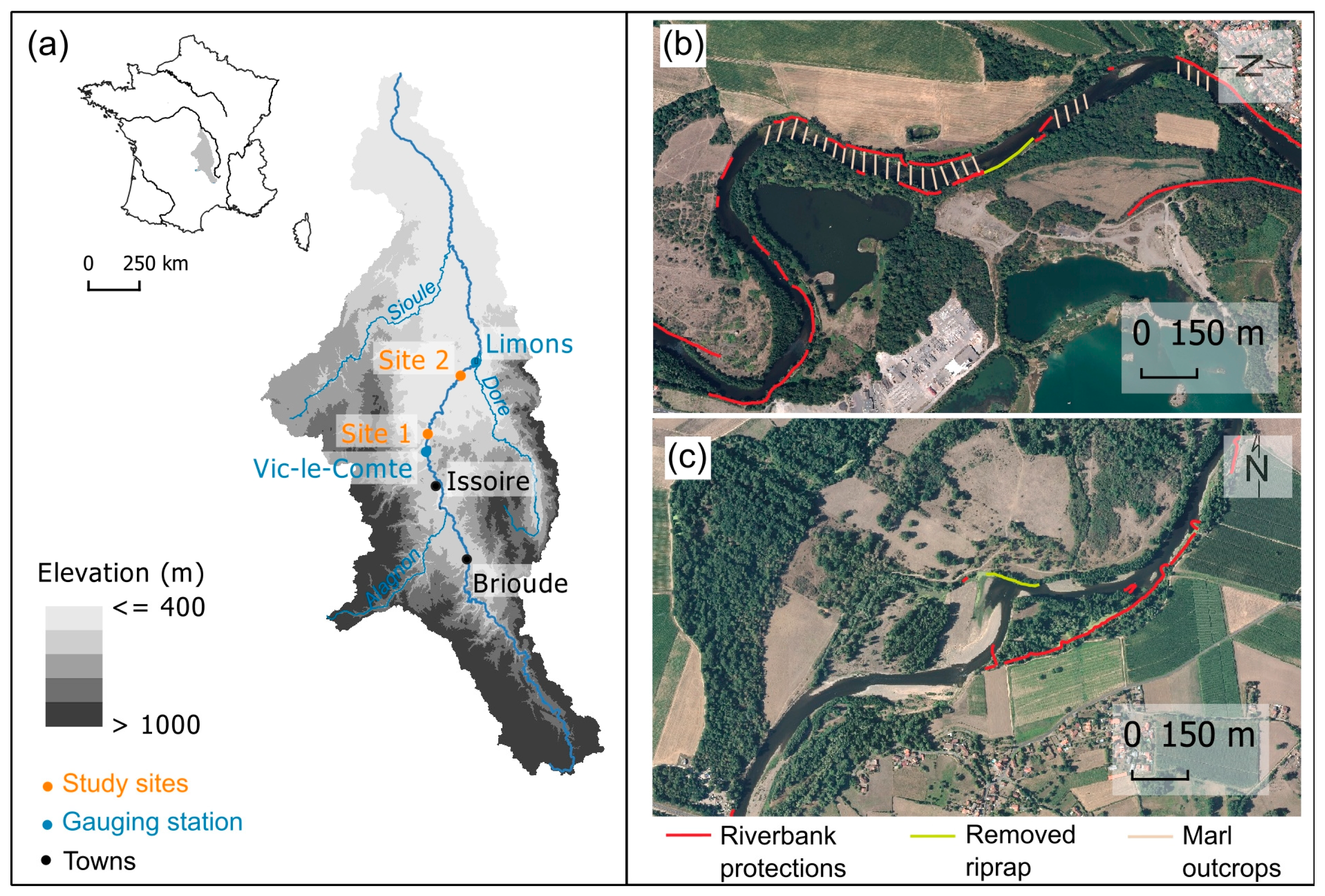
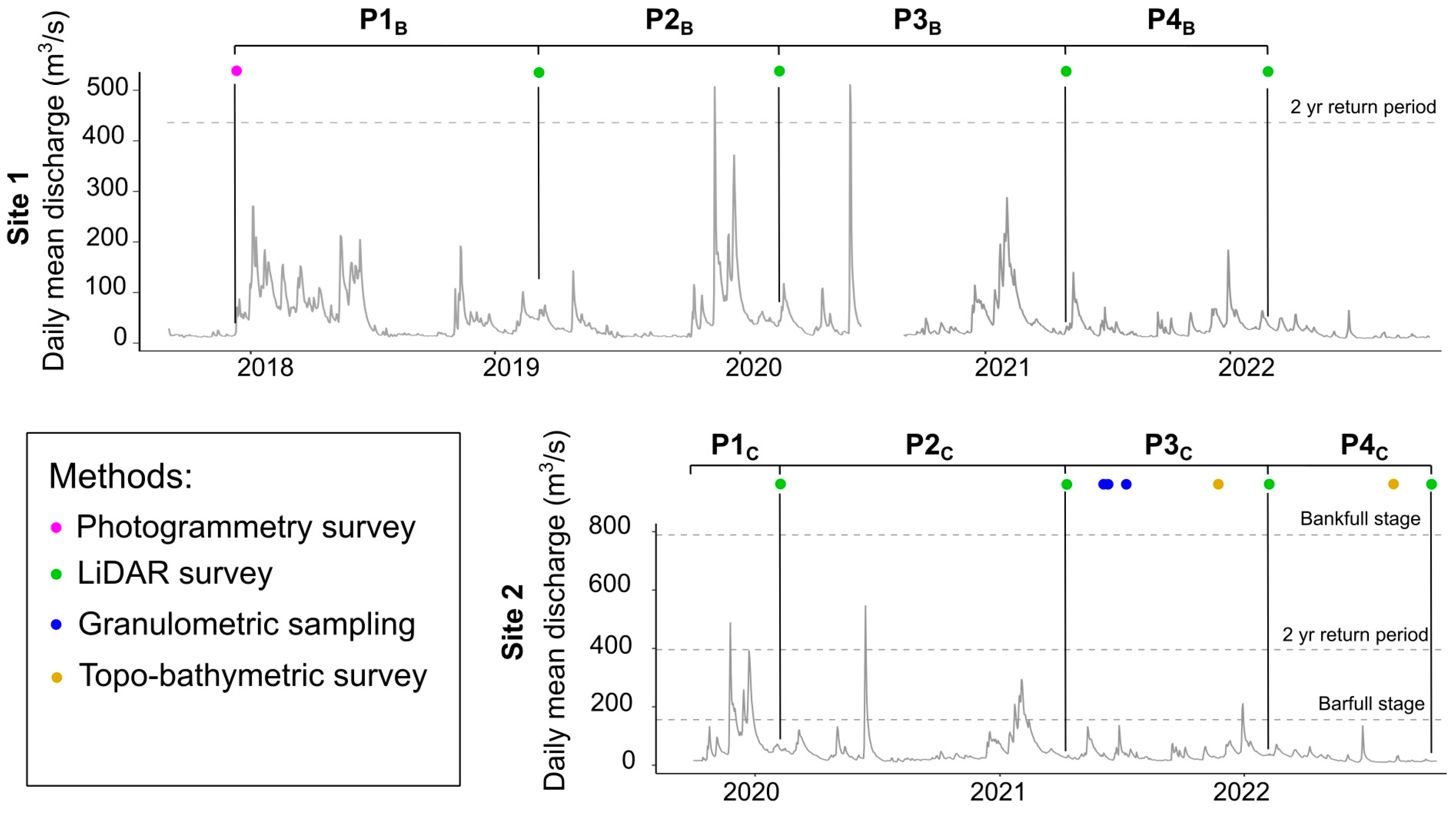

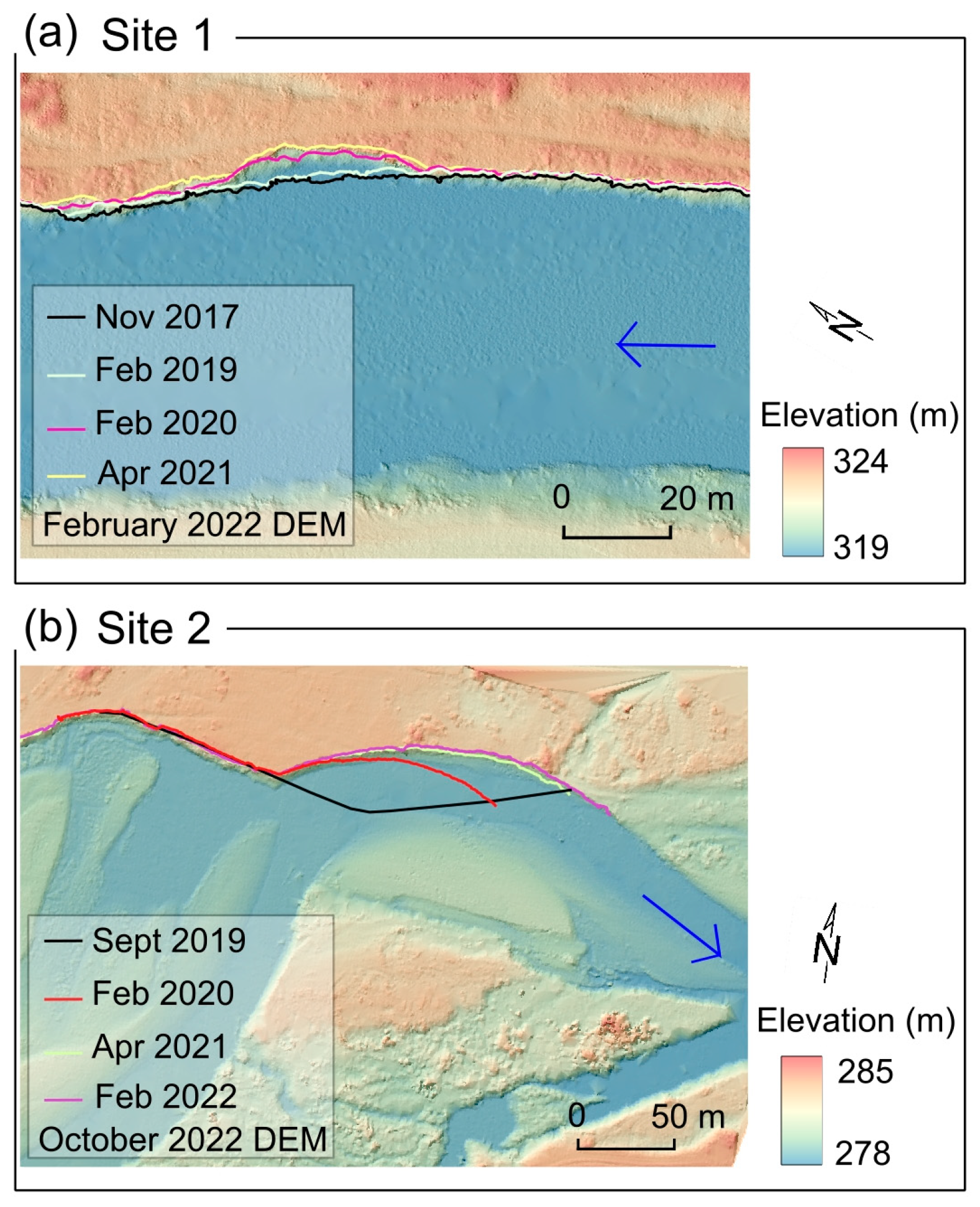


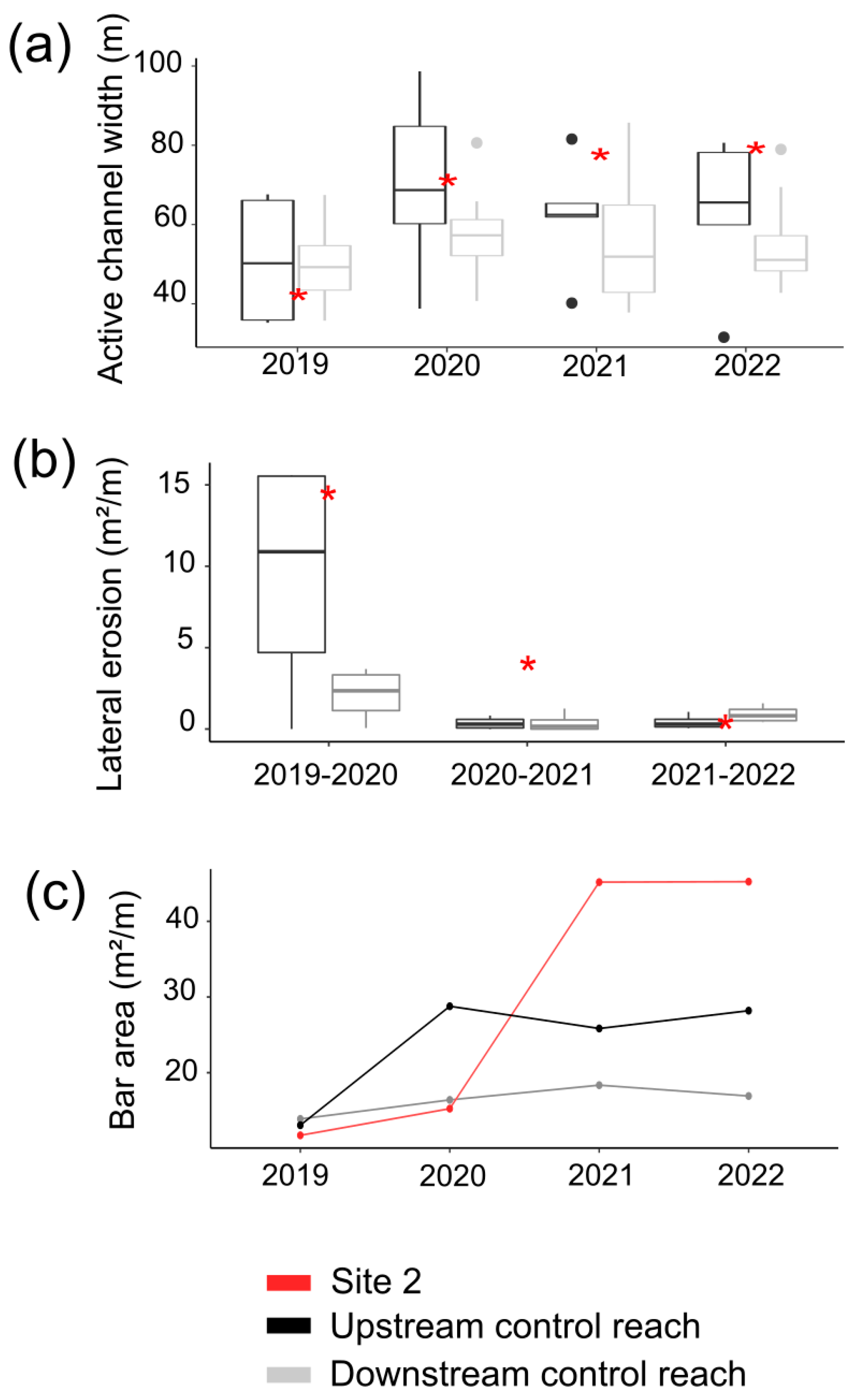

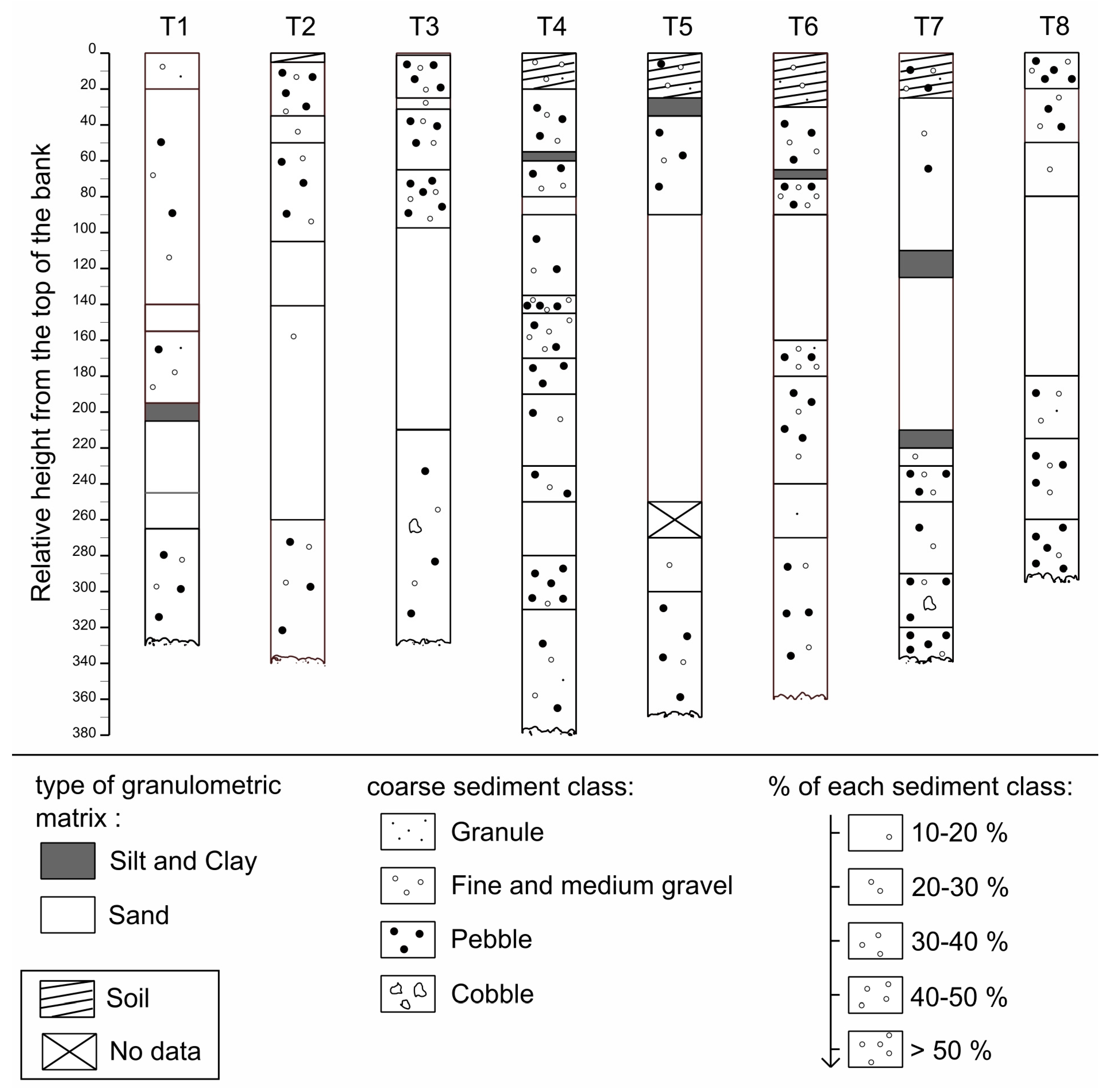
| Years | River | Restoration Objectives | Monitoring Restoration | Scientific Article | Database Completeness | ||
|---|---|---|---|---|---|---|---|
| Before | After | REFROM | RESTORE | ||||
| 2000 | Lahn (Germany) | Habitats | x | [19,20] | + | ||
| 2004–2008 | Ems (Germany) | Channel dynamics | x | x | + | + | |
| 2005–2006 | Meuse (The Netherlands) | Ecological and morphological | x | x | +++ | ++ | |
| 2005–2018 | Adour (France) | Freedom space | x | + | +++ | ||
| 2006–2010 | Lippe (Germany) | Habitats | x | +++ | |||
| ?–2007 | Mur (Austria) | Balance sediment budget | x | x | [21] | ||
| 2008–2010 | Meuse (The Netherlands) | Improve natural value | x | [22] | |||
| 2009–2013 | Mur (Austria/Slovenia) | Ecological and hydrological | + | ||||
| 2010–2017 | Old Rhine (France/Germany) | Sediment budget and dynamics | x | x | [23,24] | ||
| 2010–2015 | Upper Mur (Austria) | Habitats | + | ||||
| 2012 | Allt Lorgy (Scotland) | Morphology and habitats | x | x | [25] | + | |
| 2012–2014 | Frome (England) | ? | x | x | + | ||
| ? | Danube (?) | Fluvial landscape | + | ||||
| 2018 | Mulde River (Germany) | Revitalization | x | x | [26] | ||
| Site 1 | Site 2 | |
|---|---|---|
| Name of nearest gauging station | Vic-le-Comte | Limons |
| Active channel width (m) | 44 | 43 |
| Water slope (m/m) | 0.0015 | 0.0015 |
| Incision 1935–2020 (m) | −1 | −1.44 |
| Interannual discharge (m3/s) | 60.5 | 69 |
| Two-year flood (m3/s) | 436 | 396 |
| Specific stream power (W/m2) | 146 | 135 |
| Barfull stage (m3/s) | / | 156 |
| Bankfull stage (m3/s) | / | 789 |
| Floodplain land use | Alluvial forest | Grazing |
| Riprap protection linear | Important | Moderate |
| Channel bed features | Marl outcrops | Alluvial channel bed |
| D50 (mm) | 47 | 30 |
| D90 (mm) | 102 | 62 |
| Upstream Control Reach | Downstream Control Reach | |
|---|---|---|
| Linear distance to Site 2 (km) | 79 | 9 |
| Reach length (km) | 1.3 | 2.4 |
| Nearest gauging station | Agnat | Limons |
| Interannual discharge (m3/s) | 29 | 69 |
| Water slope (m/m) | 0.0022 | 0.0011 |
| Floodplain land use | Cultivated fields | Mainly alluvial forest |
| Channel bed features | Alluvial bed | Marl outcrops |
| D50 (mm) | 60 | 26 |
| D90 (mm) | 110 | 57 |
| Human infrastructure | Degraded ripraps | Road bridge and ripraps |
| Survey Date | Method | Daily Mean Discharge (m3/s) | Water Surface Elevation (m) |
|---|---|---|---|
| 21 November 2017 | P | 13.9 | |
| 12 February 2019 | L | 87.8 | 319.9 |
| 7 February 2020 | L | 46.8 | 319.5 |
| 8 April 2021 | L | 21.5 | 319.2 |
| 3 February 2022 | L | 28.9 | 319.3 |
| Survey Date | Method | Daily Mean Discharge (m3/s) | Water Surface Elevation (m) |
|---|---|---|---|
| 7 February 2020 | L | 56.3 | 280.24 |
| 8 April 2021 | L | 26.6 | 279.73 |
| 4 February 2022 | L | 35.7 | 279.85 |
| 7 October 2022 | L | 13.4 | 279.35 |
Disclaimer/Publisher’s Note: The statements, opinions and data contained in all publications are solely those of the individual author(s) and contributor(s) and not of MDPI and/or the editor(s). MDPI and/or the editor(s) disclaim responsibility for any injury to people or property resulting from any ideas, methods, instructions or products referred to in the content. |
© 2023 by the authors. Licensee MDPI, Basel, Switzerland. This article is an open access article distributed under the terms and conditions of the Creative Commons Attribution (CC BY) license (https://creativecommons.org/licenses/by/4.0/).
Share and Cite
Arfeuillère, A.; Steiger, J.; Gautier, E.; Petit, S.; Roussel, E.; Vautier, F.; Voldoire, O.; Saillard, J. Removal of Riprap within Channelized Rivers: A Solution for the Restoration of Lateral Channel Dynamics and Bedload Replenishment? Appl. Sci. 2023, 13, 2981. https://doi.org/10.3390/app13052981
Arfeuillère A, Steiger J, Gautier E, Petit S, Roussel E, Vautier F, Voldoire O, Saillard J. Removal of Riprap within Channelized Rivers: A Solution for the Restoration of Lateral Channel Dynamics and Bedload Replenishment? Applied Sciences. 2023; 13(5):2981. https://doi.org/10.3390/app13052981
Chicago/Turabian StyleArfeuillère, Anaïs, Johannes Steiger, Emmanuèle Gautier, Stéphane Petit, Erwan Roussel, Franck Vautier, Olivier Voldoire, and Julien Saillard. 2023. "Removal of Riprap within Channelized Rivers: A Solution for the Restoration of Lateral Channel Dynamics and Bedload Replenishment?" Applied Sciences 13, no. 5: 2981. https://doi.org/10.3390/app13052981





